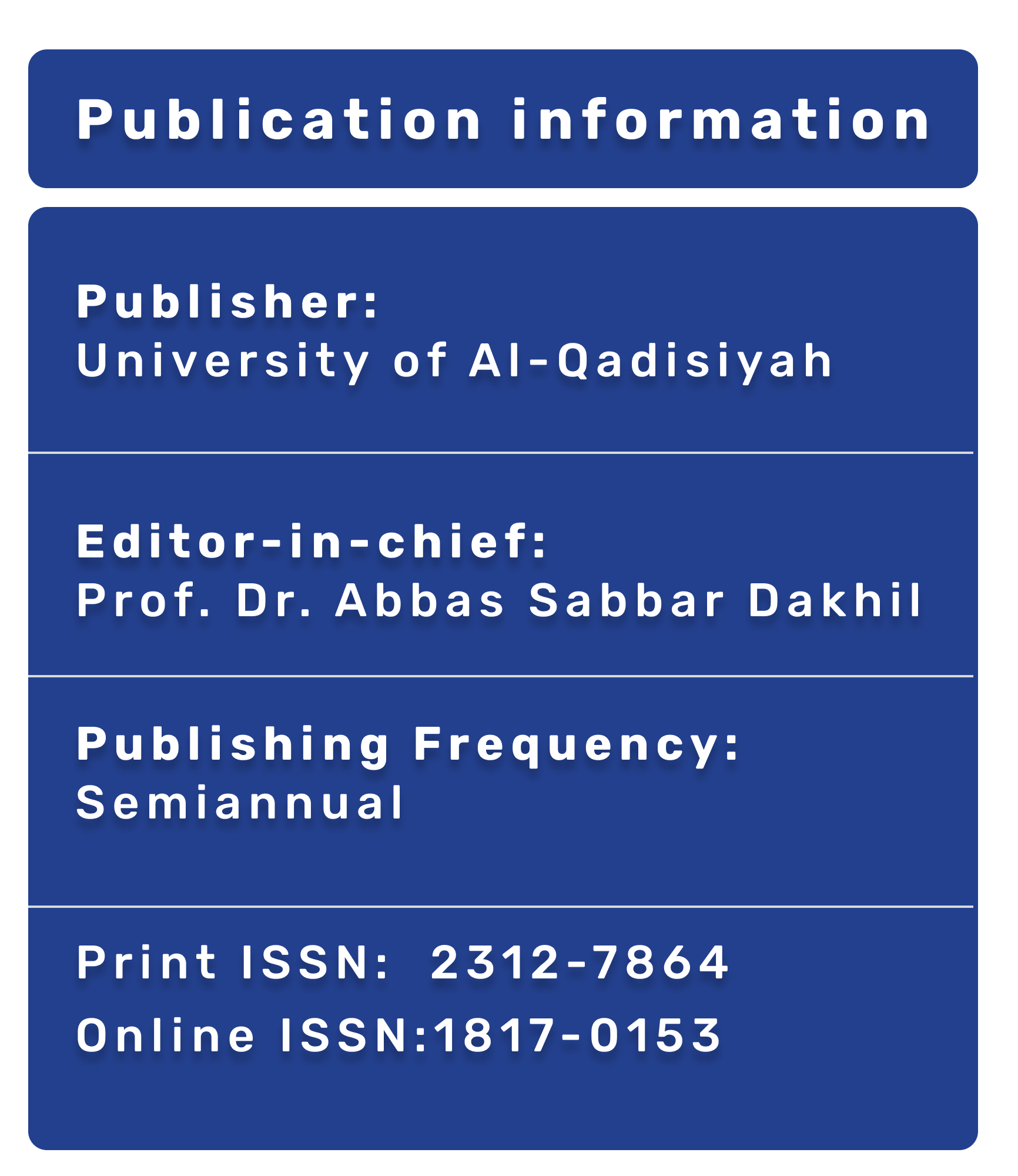Specific risk factors for occurrence of Atrial fibrillation AF in type 2 diabetic patients in CCU of Al diwaniyah Teaching Hospital / Iraq
DOI:
https://doi.org/10.28922/qmj.v20i1.929Abstract
Atrial fibrillation (AF) is the most common type of sustained cardiac arrhythmia, impacting a substantial number of people worldwide. Type 2 diabetes (T2D) is a chronic condition that can negatively influence the cardiovascular system and is often associated with an elevated risk of AF, However, the interplay between T2D and AF and the risk factors contributing to the occurrence of AF in T2D patients are not completely understood, especially in the context of critically ill patients in the critical care unit (CCU).
References
January, C. T., Wann, L. S., Alpert, J. S., Calkins, H., Cigarroa, J. E., Cleveland Jr, J. C., ... & Murray, K. T. (2014). 2014 AHA/ACC/HRS guideline for the management of patients with atrial fibrillation: a report of the American College of Cardiology/American Heart Association Task Force on practice guidelines and the Heart Rhythm Society. Journal of the American College of Cardiology, 64(21), e1-e76. https://doi.org/10.1161/CIR.0000000000000665.
Huxley, R. R., Filion, K. B., Konety, S., & Alonso, A. (2011). Meta-analysis of cohort and case-control studies of type 2 diabetes mellitus and risk of atrial fibrillation. The American journal of cardiology, 108(1), 56-62. DOI: 10.1016/j.amjcard.2011.03.004.
Sherif, S., Sumpio, B. E., & Inzucchi, S. E. (2020). The global burden of type 2 diabetes: a review. Current diabetes reports, 20(11), 1-9. doi: 10.2991/jegh.k.191028.001.
Domingueti, C. P., et al. (2016). "Diabetes mellitus: the linkage between oxidative stress, inflammation, hypercoagulability and vascular complications." Journal of Diabetes and its Complications 30(4): 738-745. DOI: 10.1016/j.jdiacomp.2015.12.018
Go AS, et al. Prevalence of diagnosed atrial fibrillation in adults: national implications for rhythm management and stroke prevention: the AnTicoagulation and Risk Factors in Atrial Fibrillation (ATRIA) Study. JAMA. 2001;285(18):2370-2375. . doi:10.1001/jama.285.18.2370
Benjamin EJ, Levy D, Vaziri SM, D'Agostino RB, Belanger AJ, Wolf PA. Independent risk factors for atrial fibrillation in a population-based cohort. The Framingham Heart Study. JAMA. 1994 Mar 16;271(11):840-4. https://doi.org/10.1161/01.CIR.98.10.946.
Huxley RR, et al. Risk of all-cause mortality and vascular events in women versus men with type 1 diabetes: a systematic review and meta-analysis. Lancet Diabetes Endocrinol. 2015;3(3):198-206.). DOI: 10.1016/S2213-8587(14)70248-7
Patel P, et al. Atrial fibrillation in the elderly: The potential contribution of reactive oxygenspecies. J Geriatr Cardiol. 2014;11(3):258-263.). DOI: 10.3724/SP.J.1263.2012.08141
Tadic, M. and C. Cuspidi (2015). "Type 2 diabetes mellitus and atrial fibrillation: from mechanisms to clinical practice." Archives of cardiovascular diseases 108(4): 269-276. https://doi.org/10.1016/j.acvd.2015.01.009.
Conen D, et al. Alcohol consumption and risk of incident atrial fibrillation in women. JAMA. 2008;300(21):2489-2496. doi:10.1001/jama.2008.755
Heeringa J, et al. Cigarette smoking and risk of atrial fibrillation: the Rotterdam Study. Am Heart J. 2008;156(6):1163-1169.). DOI: 10.1016/j.ahj.2008.08.003
Kannel, W. B. and E. J. Benjamin (2008). "Status of the epidemiology of atrial fibrillation." Medical Clinics of North America 92(1): 17-40. https://doi.org/10.1016/j.mcna.2007.09.002.
Piccini, J. P., et al. (2012). "Incidence and prevalence of atrial fibrillation and associated mortality among Medicare beneficiaries: 1993–2007." Circulation: Cardiovascular Quality and Outcomes 5(1): 85-93. https://doi.org/10.1161/CIRCOUTCOMES.111.962688.
Friberg, J., et al. (2003). "Sex-specific increase in the prevalence of atrial fibrillation (The Copenhagen City Heart Study)." The American journal of cardiology 92(12): 1419-1423. https://doi.org/10.1016/j.amjcard.2003.08.050
Wang TJ, Parise H, Levy D, et al. Obesity and the risk of new-onset atrial fibrillation. JAMA. 2004;292(20):2471-2477. doi:10.1001/jama.292.20.2471
Mountantonakis, S. E., et al. (2021). "Atrial fibrillation is an independent predictor for in-hospital mortality in patients admitted with SARS-CoV-2 infection." Heart rhythm 18(4): 501-507. DOI: 10.1016/j.hrthm.2021.01.018
Özdemir, ?. H., et al. (2021). "Permanent atrial fibrillation portends poor outcomes in hospitalized patients with COVID-19: A retrospective observational study." Journal of Electrocardiology 65: 113-120. DOI: 10.1016/j.jelectrocard.2021.01.016
Spinoni, E. G., et al. (2021). "Contribution of atrial fibrillation to in-hospital mortality in patients with COVID-19." Circulation: arrhythmia and electrophysiology 14(2): e009375. https://doi.org/10.1161/CIRCEP.120.009375
Zylla, M. M., et al. (2021). "Predictors and prognostic implications of cardiac arrhythmias in patients hospitalized for COVID-19." Journal of Clinical Medicine 10(1): 133. DOI: 10.3390/jcm10010133
Peterson, E., et al. (2020). "The relationship between coronary artery disease and clinical outcomes in COVID-19: a single-center retrospective analysis." Coronary Artery Disease 32(5): 367-371. DOI: 10.1097/MCA.0000000000000934
van Gerwen, M., et al. (2021). "Risk factors and outcomes of COVID?19 in New York City; a retrospective cohort study." Journal of medical virology 93(2): 907-915. DOI: 10.1002/jmv.26337
Inciardi, R. M., et al. (2020). "Characteristics and outcomes of patients hospitalized for COVID-19 and cardiac disease in Northern Italy." European heart journal 41(19): 1821-1829. DOI: 10.1093/eurheartj/ehaa388
Fumagalli, S., et al. (2020). "Covid-19 cases in a no-Covid-19 geriatric acute care setting. A sporadic occurrence?" European journal of internal medicine 77: 141-142. DOI: 10.1016/j.ejim.2020.04.058
Onder, G., et al. (2020). "Case-fatality rate and characteristics of patients dying in relation to COVID-19 in Italy." Jama 323(18): 1775-1776. doi:10.1001/jama.2020.4683
Patone, M., et al. (2022). "Risks of myocarditis, pericarditis, and cardiac arrhythmias associated with COVID-19 vaccination or SARS-CoV-2 infection." Nature medicine 28(2): 410-422. https://doi.org/10.1038/s41591-021-01630-0
Ajmera, K. M. (2022). "Association between COVID-19 vaccine and new-onset atrial fibrillation." Cardiology and Cardiovascular Medicine 6(1): 1-6. doi: 10.20944/preprints202306.0329.v1
Ariansen, I., et al. (2012). "Impact of alcohol habits and smoking on the risk of new-onset atrial fibrillation in hypertensive patients with ECG left ventricular hypertrophy: the LIFE study." Blood Pressure 21(1): 6-11. DOI: 10.3109/08037051.2011.622978
Chamberlain, A. M., et al. (2011). "Smoking and incidence of atrial fibrillation: results from the Atherosclerosis Risk in Communities (ARIC) study." Heart rhythm 8(8): 1160-1166. DOI: 10.1016/j.hrthm.2011.03.038
Foy, C. G., et al. (2005). "Smoking and incidence of diabetes among US adults: findings from the Insulin Resistance Atherosclerosis Study." Diabetes care 28(10): 2501-2507. https://doi.org/10.2337/diacare.28.10.2501
Will, J. C., et al. (2001). "Cigarette smoking and diabetes mellitus: evidence of a positive association from a large prospective cohort study." International journal of epidemiology 30(3): 540-546. DOI: 10.1093/ije/30.3.540
Beziaud, F., et al. (2004). "Cigarette smoking and diabetes mellitus." Diabetes & metabolism 30(2): 161-166. DOI: 10.1016/s1262-3636(07)70102-7
Kodama, S., et al. (2011). "Alcohol consumption and risk of atrial fibrillation: a meta-analysis." Journal of the American College of Cardiology 57(4): 427-436. DOI: 10.1016/j.jacc.2010.08.641
Conen, D., et al. (2010). "Caffeine consumption and incident atrial fibrillation in women." The American journal of clinical nutrition 92(3): 509-514. https://doi.org/10.3945/ajcn.2010.29627.








